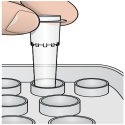Perform a Template Line Wash
|
1.
|
Prepare fresh wash solution with Tween 20 and laboratory-grade water: |
|
a.
|
Add 5 ml 100% Tween 20 ml to 45 ml laboratory-grade water. These volumes result in 10% Tween 20. |
|
b.
|
Add 25 ml 10% Tween 20 ml to 475 ml laboratory-grade water. These volumes result in a 0.5% Tween 20 wash solution. |
|
c.
|
Invert five times to mix. |
|
2.
|
Prepare fresh NaOCl wash solution with laboratory-grade water: |
|
a.
|
Add 36 µl of 5% NaOCl to 864 µl laboratory-grade water. These volumes result in a 1:25 NaOCl dilution. |
|
b.
|
Add 50 µl of the 1:25 NaOCl dilution to 950 µl of laboratory-grade water in a MiSeqtube (part # MS-102-9999). |
Using the correct concentration of NaOCl is important. Make sure to check the percentage of NaOCl on the product label. If the concentration is too high, it can make cluster generation fail in subsequent runs. If 5% NaOCl is not available, make a 1 ml solution of 0.01% NaOCl in laboratory-grade water. Do not use NaOCl with a maintenance wash or a standby wash.
|
3.
|
Prepare the wash components with fresh wash solution: |
|
a.
|
Add 6 ml wash solution to each reservoir of the wash tray, except for the reservoir numbered 17. |
|
b.
|
Add 350 ml wash solution to the 500 ml wash bottle. |
|
4.
|
Insert the MiSeq tube containing 0.01% NaOCl wash solution in reservoir 17 of the wash tray until the neck of the tube is flush with the tray. |
MiSeq Tube in Position 17 of the Wash Tray

Make sure to insert the MiSeq tube with NaOCl into tray position 17 only. Inserting the tube in another position can make cluster generation fail in subsequent runs, and can damage the fluidic system of the MiSeq instrument.
|
5.
|
When the run is complete, select Start Wash. The software automatically raises the sippers in the reagent chiller. |
|
6.
|
Select Perform optional template line wash on the Post-Run Wash screen. |
When using the VeriSeq PGS workflow, the option Perform optional template line wash is preselected for you. The MCS tracks the type of post-run wash performed after each run. If Perform optional template line wash is not selected for the post-run wash, a message on the Run Review screen reminds you the next time you start a sequencing run.
|
7.
|
Open the reagent compartment door and reagent chiller door and slide the used reagent cartridge from the chiller. |
|
8.
|
Slide the wash tray into the reagent chiller until it stops, and then close the reagent chiller door. |
|
9.
|
Raise the sipper handle in front of the PR2 bottle and waste bottle until it locks into place. |
|
10.
|
Remove the PR2 bottle and replace it with the wash bottle. |
Discard the PR2 bottle after each run. Do not reuse any remaining PR2.
|
11.
|
Remove the waste bottle and discard the contents appropriately. Return the waste bottle to the reagent compartment. |
This set of reagents contains potentially hazardous chemicals. Personal injury can occur through inhalation, ingestion, skin contact, and eye contact. Ventilation should be appropriate for handling of hazardous materials in reagents. Wear protective equipment, including eye protection, gloves, and laboratory coat appropriate for risk of exposure. Handle used reagents as chemical waste and discard in accordance with applicable regional, national, and local laws and regulations. For additional environmental, health, and safety information, refer to the SDS at support.illumina.com/sds.html.
|
12.
|
Slowly lower the sipper handle, making sure that the sippers lower into the wash bottle and waste bottle. |
|
13.
|
Close the reagent compartment door. |
When the wash is complete, leave the used flow cell, wash tray, and wash bottle containing the remaining wash solution on the instrument.
The sippers remain in the down position. Leave the unused wash solution in the wash tray and wash bottle to prevent the sippers from drying out and air from entering the system.

